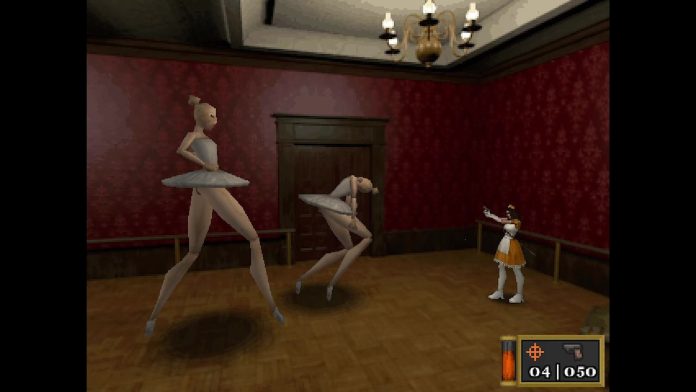It’s always tricky to review games that come out of the mind of a single developer, as I feel I must take into account the fact that this is one person’s passion project rather than the result of a faceless studio.
The developer in question here is Caspar Croes, and in conjunction with Top Hat Studios has brought us a game called Alisa Developer’s Cut. Billed as a “Classic late 90’s style horror themed action adventure game set in a fantasy universe”, it’s my job to try and put some flesh on the bones of that description. So let’s go back in time to the 1920’s as we try and solve the mystery that Alisa finds herself caught in.

The presentation of the game will be very familiar if, like me, you played the first Resident Evil on the original PlayStation. Like its illustrious forebear, Alisa has pre-rendered backdrops and a fixed camera angle, usually done for dramatic reasons rather than to give the best view of the action, it has to be said. The characters are shown on top of these still backdrops, in true 90’s style. The design of those characters, as well as the enemies, comes with that authentic feel too; slightly stiff and blocky. It looks like an obscure game you missed thirty years ago, to be honest, but that does mean Alisa Developer’s Cut captures the time perfectly.
The sound is again of its time, complete with dodgy voice acting as is required in this genre. The music is nice, and the clomping footsteps as you explore are all perfect. In fact, the only thing missing is the animation when you open a door or walk up some stairs to make it absolutely bang on! Still, as a recreation of the heyday of these games, Alisa is great.
Story is as equally weird as the source material. We play as the titular Alisa – an Elite Royal Agent. You can read that as basically being a police employee. It’s here where we are sent on a mission to catch a spy but while chasing him through some woods, we find ourselves in a pit in the ground. Before we can do anything, three doll-like contraptions burst out of the soil, grabbing hold and taking us underground. When we awaken some time later, we are dressed in a weird kind of child’s dress and while we find our pistol quickly, it seems that the scene is set to traverse some kind of gothic Victorian mansion. A mansion that is inhabited by mechanical dolls. Worse than that, those dolls aren’t friendly!
Luckily, it seems that bullets work just fine in putting them down, so now all we need to do is explore the house and escape. What could be easier? Well, given the house was seemingly designed by the same person who created the one found in Resident Evil, probably quite a lot of things…

The problem is, Alisa Developer’s Cut is a bit of a mixed bag in terms of gameplay. The thing is, and this is true of all games of this type, the gaming industry has moved on since the ’90s, and so the control system seems almost wilfully designed to get you killed.
You see, in Alisa pressing forward on the stick will always move Alisa forward, in the direction she is facing. If you want to manoeuvre around a corner, for instance, you have to turn, then press forward again to walk in the new direction. No matter how many times I tell myself this, I keep running in circles as I try to utilise a more modern control method on a game that won’t accept it.
Add into this problems in aiming (more on this in a moment) and enemies who like to close the distance to you rather quickly, and the recipe is not a happy one. I know why the scheme was devised this way, and – again – it’s how Resident Evil was powered back in the day, but we didn’t know any better then, and now we do. This is one area where I wish that Alisa Developer’s Cut had allowed just a touch of modernity to creep in.
As I mentioned aiming above, this is another area where improvements could have been made. One of the questions that you are asked upon starting a new game is whether you want to enable auto aim or not. This will apparently make it easier to shoot enemies, in return for getting less of the game’s currency – toothed wheels – from each foe you down. However, auto aim is an odd beast, having tried it both ways. When you have auto aim chosen, when you press the button to aim, Alisa will snap her aim to the point that the enemy is at, at that moment – if they move, she doesn’t adjust her aim. You have to release aim and press it again to aim again. This causes issues, especially when we consider the small, fast enemies that scuttle about on the floor!

However, all is not lost, as the puzzles found in Alisa Developer’s Cut are straight out of the Resi playbook, even down to doors having symbols on that we need to find the corresponding key for. Careful exploration and a healthy dose of running away will get to these gems all the quicker. And remembering where you saw the clue for the puzzle you have just found is half of the battle! It is in these sections that Alisa shines, and becomes very enjoyable.
So, to conclude – Alisa Developer’s Cut is a perfect representation of a period in gaming that has had its time. The controls feel clunky and the combat is difficult, not because of the enemies, but because of the aiming mechanic. Thankfully the puzzles are great; the cherry on the cake.
If you are looking for a slice of gaming nostalgia, Alisa Developer’s Cut will hit the spot, but be aware that the controls take an awful lot of getting used to.







